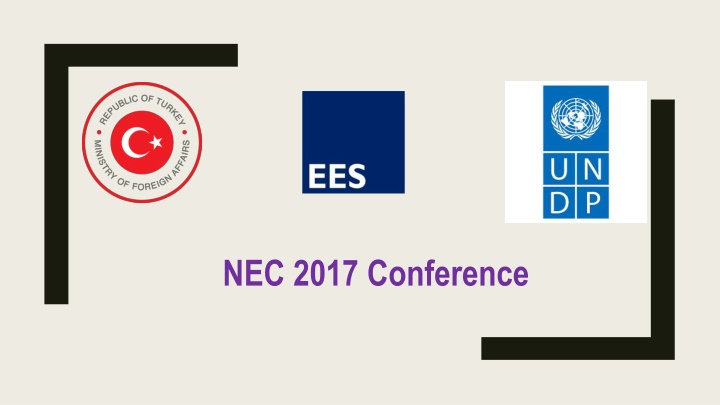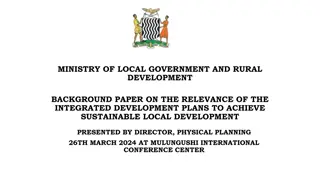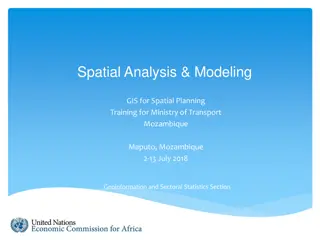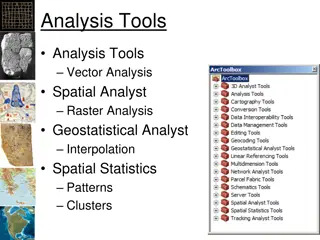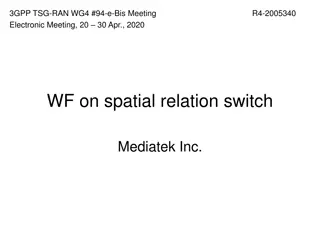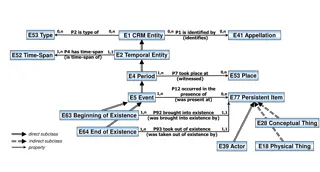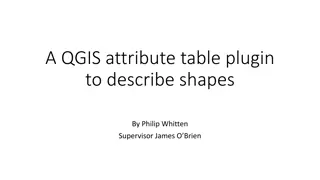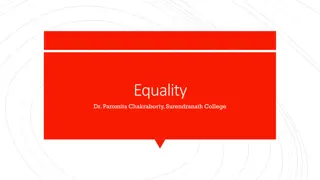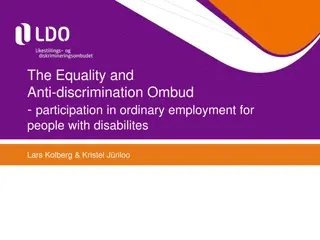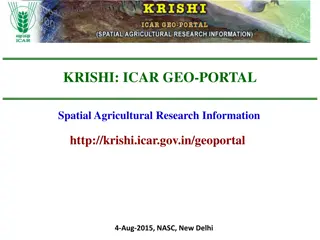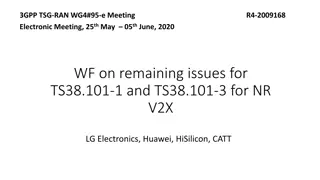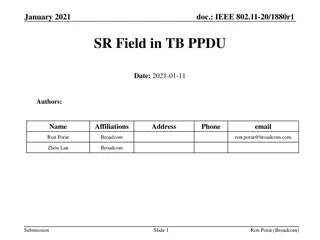Regional Conference on Sustainable Development and Spatial Equality
Delve into the discussions and evaluations at the NEC 2017 Conference, focusing on sustainable development, social equality, and spatiality for ensuring no one is left behind in the pursuit of inclusive growth. Explore the intersections between SDGs, indicators, and the concept of spatiality in promoting holistic development.
Download Presentation

Please find below an Image/Link to download the presentation.
The content on the website is provided AS IS for your information and personal use only. It may not be sold, licensed, or shared on other websites without obtaining consent from the author.If you encounter any issues during the download, it is possible that the publisher has removed the file from their server.
You are allowed to download the files provided on this website for personal or commercial use, subject to the condition that they are used lawfully. All files are the property of their respective owners.
The content on the website is provided AS IS for your information and personal use only. It may not be sold, licensed, or shared on other websites without obtaining consent from the author.
E N D
Presentation Transcript
UNDP Regional Bureau for Europe and CIS The Government of the Republic of Turkey The European Evaluation Society (EES) NEC 2017 Conference
NEC 2017 Conference National Evaluation Capacities Conference 16-20 October, 2017 Istanbul, Turkey No region/space left behind? , Assessment of SDGs Indicators from Socio-Spatial View Habib Jabbari Ph.D. in Economic Sociology and Development Deputy director of Planning, Spatial Planning and Environment- Plan and Budget Organization of Iran Arezu Anvari , -Ph.D. candidate for spatial planning in Kharazmi University of Iran.
Statement the issue : No one left behind Who is no one? Is someone left behind? What about some region /space?
What about SDGs Goals & Indicators Is may be unwanted someone leaved behind ? What SDGs Goals and Indicators says us about the matters ?
What says sustainable development about this issues? Sustainable development means :humanity, Equality , inclusiveness and resiliency +spatiality Three pillars not enough for ensuring sustainable development , so we must mentioned 3+2 pillar 3 from previous: environmental ,social and economic pillars 2 new: institutional and spatial
Spatiality is more important for sustainability Spatiality" is "the quality or process of being spatial/being defined, located, or experienced in or as space. Spatiality" is " any property relating to or occupying space "Space" is just space ". "Spatiality" refers to an ongoing cultural process of taking place/making space.
SOCIAL EQUALITY GENRATION EQUALITY INTER- SUSTAINABLE SUSTAINABLE EQUALITY EQUALITY EQUALITY GENDER SATIAL EQUALITY
10:Reduce inequality within and among countries 10.1 : By 2030, progressively achieve and sustain income growth of the bottom 40% of the population at a rate higher than the national average 10.2: By 2030, empower and promote the social, economic and political inclusion of all, irrespective of age, sex, disability, race, ethnicity, origin, religion or economic or other status 10.3 : Ensure equal opportunity and reduce inequalities of outcome, including by eliminating discriminatory laws, policies and practices and promoting appropriate legislation, policies and action in this regard 10.4 : Adopt policies, especially fiscal, wage and social protection policies, and progressively achieve greater equality 10.5 :Improve the regulation and monitoring of global financial markets and institutions and strengthen the implementation of such regulations 10.6: Ensure enhanced representation and voice for developing countries in decision-making in global international economic and financial institutions in order to deliver more effective, credible, accountable and legitimate institutions 10.7: Facilitate orderly, safe, regular and responsible migration and mobility of people, including through the implementation of planned and well-managed migration policies 10.a: Implement the principle of special and differential treatment for developing countries, in particular least developed countries, in accordance with World Trade Organization agreements 10.b: Encourage official development assistance and financial flows, including foreign direct investment, to states where the need is greatest, in particular least developed countries, African countries, small island developing states and landlocked developing countries, in accordance with their national plans and programmes 10.c :By 2030, reduce to less than 3% the transaction costs of migrant remittances and eliminate remittance corridors with costs higher than 5%
11 : Make cities and human settlements inclusive, safe, resilient and sustainable 11.1 by 2030, ensure access for all to adequate, safe and affordable housing and basic services, and upgrade slums 11.2 by 2030, provide access to safe, affordable, accessible and sustainable transport systems for all, improving road safety, notably by expanding public transport, with special attention to the needs of those in vulnerable situations, women, children, persons with disabilities and older persons 11.3 by 2030 enhance inclusive and sustainable urbanization and capacities for participatory, integrated and sustainable human settlement planning and management in all countries 11.4 strengthen efforts to protect and safeguard the world s cultural and natural heritage 11.5 by 2030 significantly reduce the number of deaths and the number of affected people and decrease by y% the economic losses relative to GDP caused by disasters, including water-related disasters, with the focus on protecting the poor and people in vulnerable situations 11.6 by 2030, reduce the adverse per capita environmental impact of cities, including by paying special attention to air quality, municipal and other waste management 11.7 by 2030, provide universal access to safe, inclusive and accessible, green and public spaces, particularly for women and children, older persons and persons with disabilities 11.a support positive economic, social and environmental links between urban, peri-urban and rural areas by strengthening national and regional development planning 11.b by 2020, increase by x% the number of cities and human settlements adopting and implementing integrated policies and plans towards inclusion, resource efficiency, mitigation and adaptation to climate change, resilience to disasters, develop and implement in line with the forthcoming Hyogo Framework holistic disaster risk management at all levels 11.c support least developed countries, including through financial and technical assistance, for sustainable and resilient buildings utilizing local materials
Leave no one Leave no one behind is a behind is a core principle of SDGs SDG implementation will thus have to ensure that development gains are equitably distributed across all territories and demographic groups. Localization recognizes that different territories have different needs and priorities that can be better achieved through bottom-up approaches for development planning, and context-based implementation strategies. It helps address specific gaps in development, and has the potential to reduce territorial inequalities between places/spaces
Leave no Leave no place/ space behind place/ space behind As the only (may be two) goal that acknowledges the spatial aspects of development, Goal 11 embeds the territorial dimension of sustainable development within the SDG agenda. One of the primary concerns raised by the creation of Goal 11 is that it may promote separation between urban and rural areas. However, Goal 11 is not geared only towards cities but towards all human settlements, and SDG localization advocates a territorial approach in which local governments work with each other and with other partners to define, plan and implement the SDGs based on the unique local context, resources, challenges and opportunities of their territories (https://sdgcities.guide/chapter-1-cities-and-a-territorial-approach-to-the- sdgs-22c2660644e3).
Leave no Leave no space/ region space/ region behind behind Goal 10 is the only other goal of SDGs that acknowledges the spatial aspects of development, this goal says and trusts to be :Reduce :Reduce inequality within and among inequality within and among countries . countries . But indicators of this But indicators of this goals not cover spatially pillar of sustainable development particularly goals not cover spatially pillar of sustainable development particularly within the countries within the countries. As mentioned above only one indicator is . As mentioned above only one indicator is spatially. spatially. The other issue is spatiality pillar of sustainable development must be considering over than one. So the other pillars also require think/act in spatially manner.
Spatiality and evaluation Spatial equality requires proactive evaluation not traditionally passive cost- benefit evaluation. Main attributes of the new evaluation : Sensitive to spatial and spatiality is one of main principles Before development intervention responsible to assessment and have power to change alternatives based on principles particularly on local/community interests Impact-based evaluation not merely output and outcome based Result-based evaluation Responsible for sustainability of local/community interests not merely national /international interests. Five pillar integrated evaluation
The last point Thinking spatially Assessing spatially policies ,programmes , projects before intervention Planning spatially first Evaluating spatially
Email for contact Jabbari.habib@gmail.com jabari.h@mporg.ir.
